An Improved Ratiometric FRET Biosensor with Higher Affinity for Extracellular ATP
Abstract
1. Introduction
2. Materials and Methods
3. Results
3.1. Mutation of the ATP Binding Site
3.2. Optimization of Tether Length
3.3. Hypoosmotic ATP Release
4. Discussion
Supplementary Materials
Author Contributions
Funding
Data Availability Statement
Conflicts of Interest
References
- Pankratov, Y.; Lalo, U.; Verkhratsky, A.; North, R.A. Vesicular Release of ATP at Central Synapses. Pflugers Arch. 2006, 452, 589–597. [Google Scholar] [CrossRef]
- Burnstock, G. An Introduction to the Roles of Purinergic Signalling in Neurodegeneration, Neuroprotection and Neuroregeneration. Neuropharmacology 2016, 104, 4–17. [Google Scholar] [CrossRef]
- Glykys, J.; Dzhala, V.; Egawa, K.; Kahle, K.T.; Delpire, E.; Staley, K. Chloride Dysregulation, Seizures, and Cerebral Edema: A Relationship with Therapeutic Potential. Trends Neurosci. 2017, 40, 276–294. [Google Scholar] [CrossRef] [PubMed]
- Van der Wijk, T.; De Jonge, H.R.; Tilly, B.C. Osmotic Cell Swelling-Induced ATP Release Mediates the Activation of Extracellular Signal-Regulated Protein Kinase (Erk)-1/2 but Not the Activation of Osmo-Sensitive Anion Channels. Biochem. J. 1999, 343 Pt 3, 579–586. [Google Scholar] [CrossRef]
- Darby, M.; Kuzmiski, J.B.; Panenka, W.; Feighan, D.; MacVicar, B.A. ATP Released from Astrocytes during Swelling Activates Chloride Channels. J. Neurophysiol. 2003, 89, 1870–1877. [Google Scholar] [CrossRef]
- Suzuki-Kerr, H.; Walker, K.L.; Han, M.-H.; Lim, J.C.; Donaldson, P.J. Hyposmotic Stress Causes ATP Release in a Discrete Zone within the Outer Cortex of Rat Lens. Mol. Vis. 2022, 28, 245–256. [Google Scholar] [PubMed]
- Furuya, K.; Hirata, H.; Kobayashi, T.; Ishiguro, H.; Sokabe, M. Volume-Regulated Anion Channels Conduct ATP in Undifferentiated Mammary Cells and Promote Tumorigenesis in Xenograft Nude Mouse. Front. Cell Dev. Biol. 2024, 12, 1519642. [Google Scholar] [CrossRef]
- Davalos, D.; Grutzendler, J.; Yang, G.; Kim, J.V.; Zuo, Y.; Jung, S.; Littman, D.R.; Dustin, M.L.; Gan, W.-B. ATP Mediates Rapid Microglial Response to Local Brain Injury in Vivo. Nat. Neurosci. 2005, 8, 752–758. [Google Scholar] [CrossRef] [PubMed]
- Chen, Y.; Luan, P.; Liu, J.; Wei, Y.; Wang, C.; Wu, R.; Wu, Z.; Jing, M. Spatiotemporally Selective Astrocytic ATP Dynamics Encode Injury Information Sensed by Microglia Following Brain Injury in Mice. Nat. Neurosci. 2024, 27, 1522–1533. [Google Scholar] [CrossRef]
- Jacobson, K.A.; Müller, C.E. Medicinal Chemistry of Adenosine, P2Y and P2X Receptors. Neuropharmacology 2016, 104, 31–49. [Google Scholar] [CrossRef]
- Wu, Z.; Li, Y. New Frontiers in Probing the Dynamics of Purinergic Transmitters in Vivo. Neurosci. Res. 2020, 152, 35–43. [Google Scholar] [CrossRef]
- Dale, N. Biological Insights from the Direct Measurement of Purine Release. Biochem. Pharmacol. 2021, 187, 114416. [Google Scholar] [CrossRef] [PubMed]
- Shigetomi, E.; Sakai, K.; Koizumi, S. Extracellular ATP/Adenosine Dynamics in the Brain and Its Role in Health and Disease. Front. Cell Dev. Biol. 2023, 11, 1343653. [Google Scholar] [CrossRef]
- Heinrich, A.; Andó, R.D.; Túri, G.; Rózsa, B.; Sperlágh, B. K+ Depolarization Evokes ATP, Adenosine and Glutamate Release from Glia in Rat Hippocampus: A Microelectrode Biosensor Study. Br. J. Pharmacol. 2012, 167, 1003–1020. [Google Scholar] [CrossRef]
- Dale, N.; Frenguelli, B.G. Measurement of Purine Release with Microelectrode Biosensors. Purinergic Signal. 2012, 8, 27–40. [Google Scholar] [CrossRef][Green Version]
- Kasymov, V.; Larina, O.; Castaldo, C.; Marina, N.; Patrushev, M.; Kasparov, S.; Gourine, A.V. Differential Sensitivity of Brainstem versus Cortical Astrocytes to Changes in pH Reveals Functional Regional Specialization of Astroglia. J. Neurosci. 2013, 33, 435–441. [Google Scholar] [CrossRef] [PubMed]
- Pangršič, T.; Potokar, M.; Stenovec, M.; Kreft, M.; Fabbretti, E.; Nistri, A.; Pryazhnikov, E.; Khiroug, L.; Giniatullin, R.; Zorec, R. Exocytotic Release of ATP from Cultured Astrocytes. J. Biol. Chem. 2007, 282, 28749–28758. [Google Scholar] [CrossRef]
- Liu, T.; Sun, L.; Xiong, Y.; Shang, S.; Guo, N.; Teng, S.; Wang, Y.; Liu, B.; Wang, C.; Wang, L.; et al. Calcium Triggers Exocytosis from Two Types of Organelles in a Single Astrocyte. J. Neurosci. 2011, 31, 10593–10601. [Google Scholar] [CrossRef] [PubMed]
- Lalo, U.; Palygin, O.; Rasooli-Nejad, S.; Andrew, J.; Haydon, P.G.; Pankratov, Y. Exocytosis of ATP from Astrocytes Modulates Phasic and Tonic Inhibition in the Neocortex. PLoS Biol. 2014, 12, e1001747. [Google Scholar] [CrossRef]
- Lee, J.; Chun, Y.-E.; Han, K.-S.; Lee, J.; Woo, D.H.; Lee, C.J. Ca(2+) Entry Is Required for Mechanical Stimulation-Induced ATP Release from Astrocyte. Exp. Neurobiol. 2015, 24, 17–23. [Google Scholar] [CrossRef]
- Wang, Z.; Haydon, P.G.; Yeung, E.S. Direct Observation of Calcium-Independent Intercellular ATP Signaling in Astrocytes. Anal. Chem. 2000, 72, 2001–2007. [Google Scholar] [CrossRef]
- Fujii, Y.; Maekawa, S.; Morita, M. Astrocyte Calcium Waves Propagate Proximally by Gap Junction and Distally by Extracellular Diffusion of ATP Released from Volume-Regulated Anion Channels. Sci. Rep. 2017, 7, 13115. [Google Scholar] [CrossRef]
- Pellegatti, P.; Raffaghello, L.; Bianchi, G.; Piccardi, F.; Pistoia, V.; Di Virgilio, F. Increased Level of Extracellular ATP at Tumor Sites: In Vivo Imaging with Plasma Membrane Luciferase. PLoS ONE 2008, 3, e2599. [Google Scholar] [CrossRef]
- Wilhelm, K.; Ganesan, J.; Müller, T.; Dürr, C.; Grimm, M.; Beilhack, A.; Krempl, C.D.; Sorichter, S.; Gerlach, U.V.; Jüttner, E.; et al. Graft-versus-Host Disease Is Enhanced by Extracellular ATP Activating P2X7R. Nat. Med. 2010, 16, 1434–1438. [Google Scholar] [CrossRef] [PubMed]
- Michaud, M.; Martins, I.; Sukkurwala, A.Q.; Adjemian, S.; Ma, Y.; Pellegatti, P.; Shen, S.; Kepp, O.; Scoazec, M.; Mignot, G.; et al. Autophagy-Dependent Anticancer Immune Responses Induced by Chemotherapeutic Agents in Mice. Science 2011, 334, 1573–1577. [Google Scholar] [CrossRef] [PubMed]
- Barberà-Cremades, M.; Baroja-Mazo, A.; Gomez, A.I.; Machado, F.; Di Virgilio, F.; Pelegrín, P. P2X7 Receptor-Stimulation Causes Fever via PGE2 and IL-1β Release. FASEB J. 2012, 26, 2951–2962. [Google Scholar] [CrossRef] [PubMed]
- Rangaraju, V.; Calloway, N.; Ryan, T.A. Activity-Driven Local ATP Synthesis Is Required for Synaptic Function. Cell 2014, 156, 825–835. [Google Scholar] [CrossRef]
- Conley, J.M.; Radhakrishnan, S.; Valentino, S.A.; Tantama, M. Imaging Extracellular ATP with a Genetically-Encoded, Ratiometric Fluorescent Sensor. PLoS ONE 2017, 12, e0187481. [Google Scholar] [CrossRef]
- Lobas, M.A.; Tao, R.; Nagai, J.; Kronschläger, M.T.; Borden, P.M.; Marvin, J.S.; Looger, L.L.; Khakh, B.S. A Genetically Encoded Single-Wavelength Sensor for Imaging Cytosolic and Cell Surface ATP. Nat. Commun. 2019, 10, 711. [Google Scholar] [CrossRef]
- Wu, Z.; He, K.; Chen, Y.; Li, H.; Pan, S.; Li, B.; Liu, T.; Xi, F.; Deng, F.; Wang, H.; et al. A Sensitive GRAB Sensor for Detecting Extracellular ATP in Vitro and in Vivo. Neuron 2022, 110, 770–782.e5. [Google Scholar] [CrossRef]
- Marvin, J.S.; Kokotos, A.C.; Kumar, M.; Pulido, C.; Tkachuk, A.N.; Yao, J.S.; Brown, T.A.; Ryan, T.A. iATPSnFR2: A High-Dynamic-Range Fluorescent Sensor for Monitoring Intracellular ATP. Proc. Natl. Acad. Sci. USA 2024, 121, e2314604121. [Google Scholar] [CrossRef]
- Imamura, H.; Nhat, K.P.H.; Togawa, H.; Saito, K.; Iino, R.; Kato-Yamada, Y.; Nagai, T.; Noji, H. Visualization of ATP Levels inside Single Living Cells with Fluorescence Resonance Energy Transfer-Based Genetically Encoded Indicators. Proc. Natl. Acad. Sci. USA 2009, 106, 15651–15656. [Google Scholar] [CrossRef] [PubMed]
- Kato, S.; Yoshida, M.; Kato-Yamada, Y. Role of the Epsilon Subunit of Thermophilic F1-ATPase as a Sensor for ATP. J. Biol. Chem. 2007, 282, 37618–37623. [Google Scholar] [CrossRef]
- Kato-Yamada, Y. High Affinity Nucleotide-Binding Mutant of the ε Subunit of Thermophilic F1-ATPase. Biochem. Biophys. Res. Commun. 2016, 469, 1129–1132. [Google Scholar] [CrossRef]
- Kato-Yamada, Y.; Yoshida, M. Isolated Epsilon Subunit of Thermophilic F1-ATPase Binds ATP. J. Biol. Chem. 2003, 278, 36013–36016. [Google Scholar] [CrossRef]
- Sivaramakrishnan, S.; Spudich, J.A. Systematic Control of Protein Interaction Using a Modular ER/K α-Helix Linker. Proc. Natl. Acad. Sci. USA 2011, 108, 20467–20472. [Google Scholar] [CrossRef]
- Komatsu, N.; Aoki, K.; Yamada, M.; Yukinaga, H.; Fujita, Y.; Kamioka, Y.; Matsuda, M. Development of an Optimized Backbone of FRET Biosensors for Kinases and GTPases. Mol. Biol. Cell 2011, 22, 4647–4656. [Google Scholar] [CrossRef]
- Guthrie, P.B.; Knappenberger, J.; Segal, M.; Bennett, M.V.; Charles, A.C.; Kater, S.B. ATP Released from Astrocytes Mediates Glial Calcium Waves. J. Neurosci. 1999, 19, 520–528. [Google Scholar] [CrossRef]
- Bowser, D.N.; Khakh, B.S. Vesicular ATP Is the Predominant Cause of Intercellular Calcium Waves in Astrocytes. J. Gen. Physiol. 2007, 129, 485–491. [Google Scholar] [CrossRef] [PubMed]
- Trull, K.J.; Miller, P.; Tat, K.; Varney, S.A.; Conley, J.M.; Tantama, M. Detection of Osmotic Shock-Induced Extracellular Nucleotide Release with a Genetically Encoded Fluorescent Sensor of ADP and ATP. Sensors 2019, 19, 3253. [Google Scholar] [CrossRef] [PubMed]
- Harada, K.; Ito, M.; Wang, X.; Tanaka, M.; Wongso, D.; Konno, A.; Hirai, H.; Hirase, H.; Tsuboi, T.; Kitaguchi, T. Red Fluorescent Protein-Based cAMP Indicator Applicable to Optogenetics and in Vivo Imaging. Sci. Rep. 2017, 7, 7351. [Google Scholar] [CrossRef] [PubMed]
- Arai, S.; Kriszt, R.; Harada, K.; Looi, L.-S.; Matsuda, S.; Wongso, D.; Suo, S.; Ishiura, S.; Tseng, Y.-H.; Raghunath, M.; et al. RGB-Color Intensiometric Indicators to Visualize Spatiotemporal Dynamics of ATP in Single Cells. Angew. Chem. 2018, 57, 10873–10878. [Google Scholar] [CrossRef]
- Schena, A.; Johnsson, K. Sensing Acetylcholine and Anticholinesterase Compounds. Angew. Chem. 2014, 53, 1302–1305. [Google Scholar] [CrossRef] [PubMed]
- Shivange, A.V.; Borden, P.M.; Muthusamy, A.K.; Nichols, A.L.; Bera, K.; Bao, H.; Bishara, I.; Jeon, J.; Mulcahy, M.J.; Cohen, B.; et al. Determining the Pharmacokinetics of Nicotinic Drugs in the Endoplasmic Reticulum Using Biosensors. J. Gen. Physiol. 2019, 151, 738–757. [Google Scholar] [CrossRef]
- Unger, E.K.; Keller, J.P.; Altermatt, M.; Liang, R.; Matsui, A.; Dong, C.; Hon, O.J.; Yao, Z.; Sun, J.; Banala, S.; et al. Directed Evolution of a Selective and Sensitive Serotonin Sensor via Machine Learning. Cell 2020, 183, 1986–2002.e26. [Google Scholar] [CrossRef]
- Nasu, Y.; Aggarwal, A.; Le, G.N.T.; Vo, C.T.; Kambe, Y.; Wang, X.; Beinlich, F.R.M.; Lee, A.B.; Ram, T.R.; Wang, F.; et al. Lactate Biosensors for Spectrally and Spatially Multiplexed Fluorescence Imaging. Nat. Commun. 2023, 14, 6598. [Google Scholar] [CrossRef]
- Hellweg, L.; Edenhofer, A.; Barck, L.; Huppertz, M.-C.; Frei, M.S.; Tarnawski, M.; Bergner, A.; Koch, B.; Johnsson, K.; Hiblot, J. A General Method for the Development of Multicolor Biosensors with Large Dynamic Ranges. Nat. Chem. Biol. 2023, 19, 1147–1157. [Google Scholar] [CrossRef] [PubMed]
- Shigetomi, E.; Suzuki, H.; Hirayama, Y.J.; Sano, F.; Nagai, Y.; Yoshihara, K.; Koga, K.; Tateoka, T.; Yoshioka, H.; Shinozaki, Y.; et al. Disease-Relevant Upregulation of P2Y1 Receptor in Astrocytes Enhances Neuronal Excitability via IGFBP2. Nat. Commun. 2024, 15, 6525. [Google Scholar] [CrossRef]
- Chen, A.B.; Duque, M.; Rymbek, A.; Dhanasekar, M.; Wang, V.M.; Mi, X.; Tocquer, L.; Narayan, S.; Legorreta, E.M.; Eddison, M.; et al. Norepinephrine Changes Behavioral State through Astroglial Purinergic Signaling. Science 2025, 388, 769–775. [Google Scholar] [CrossRef]
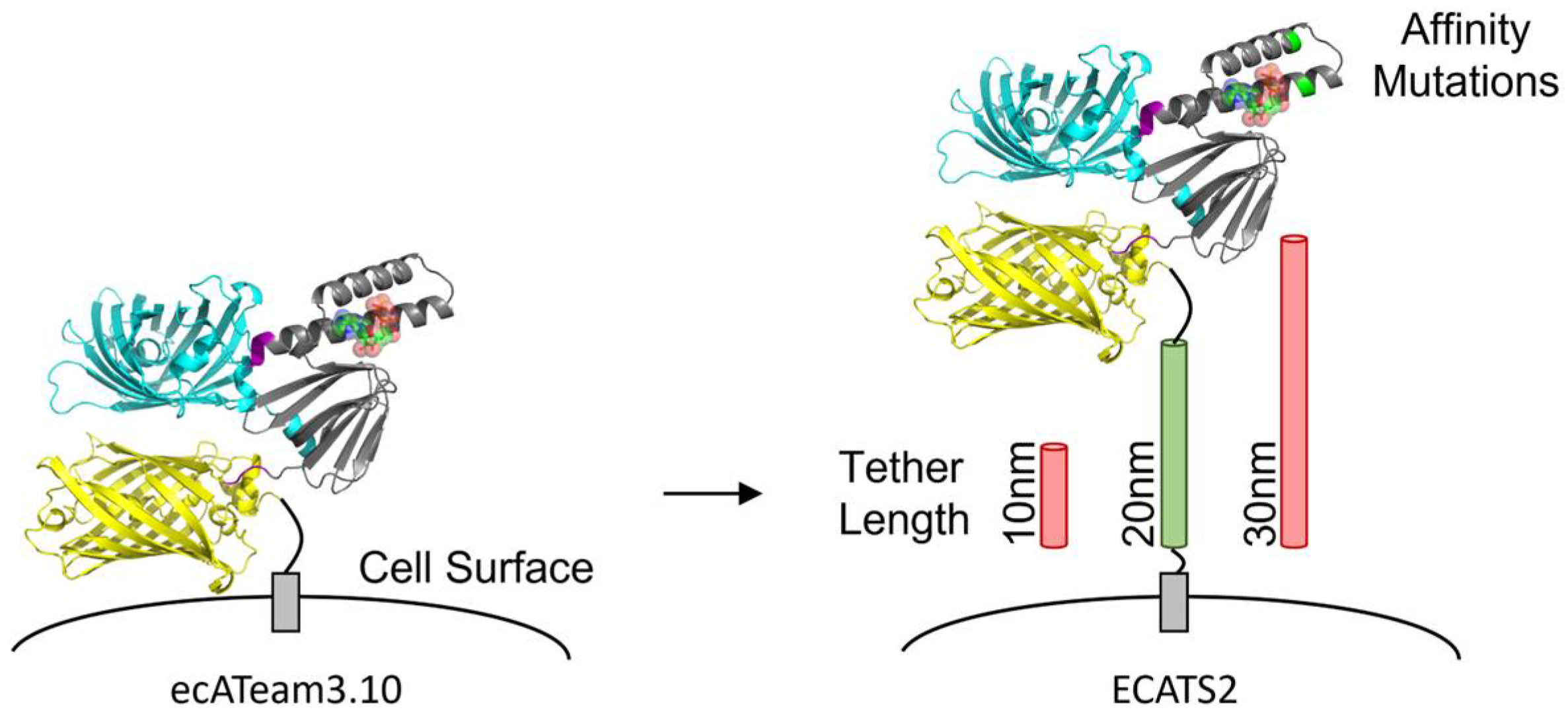

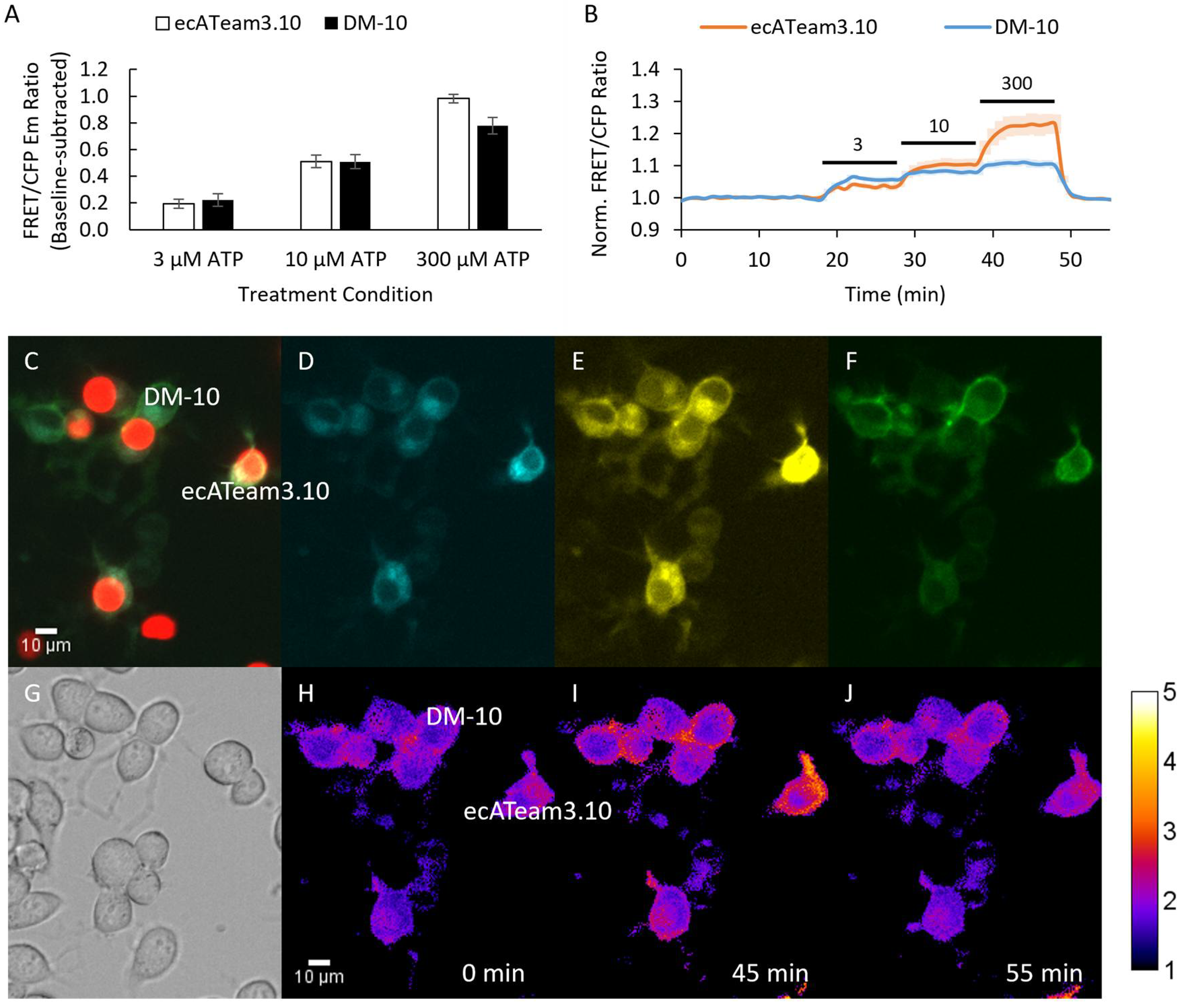

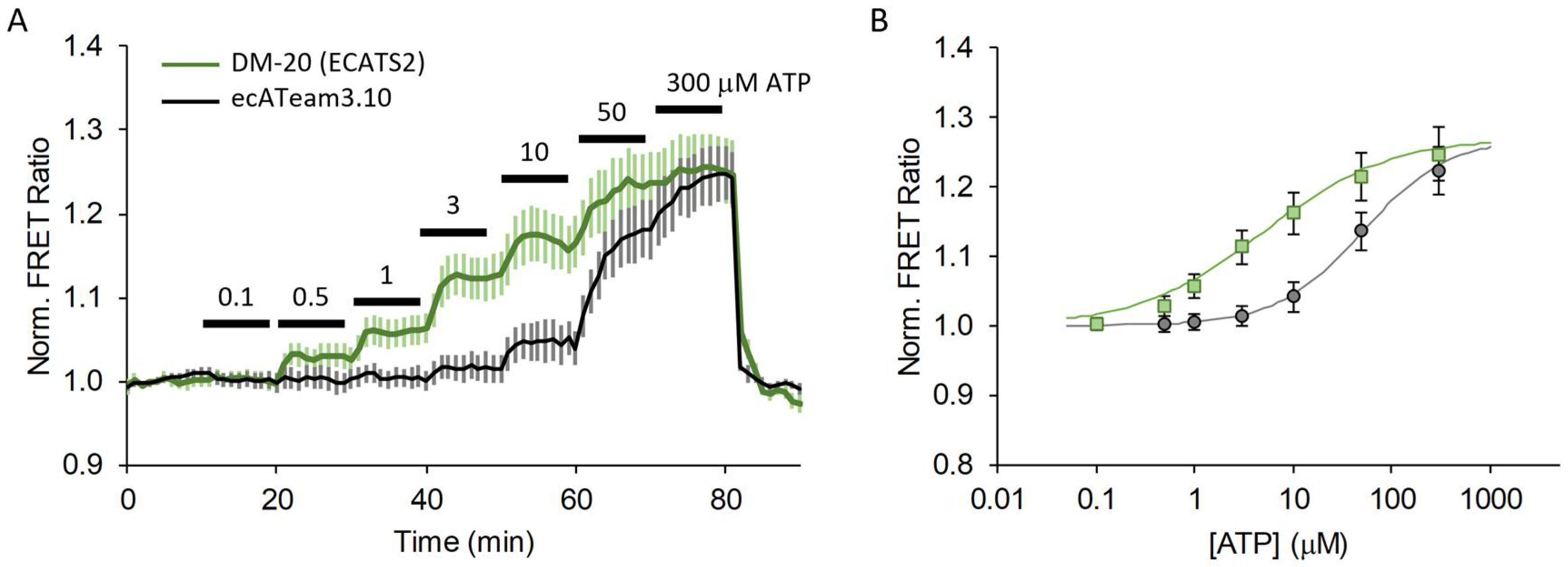
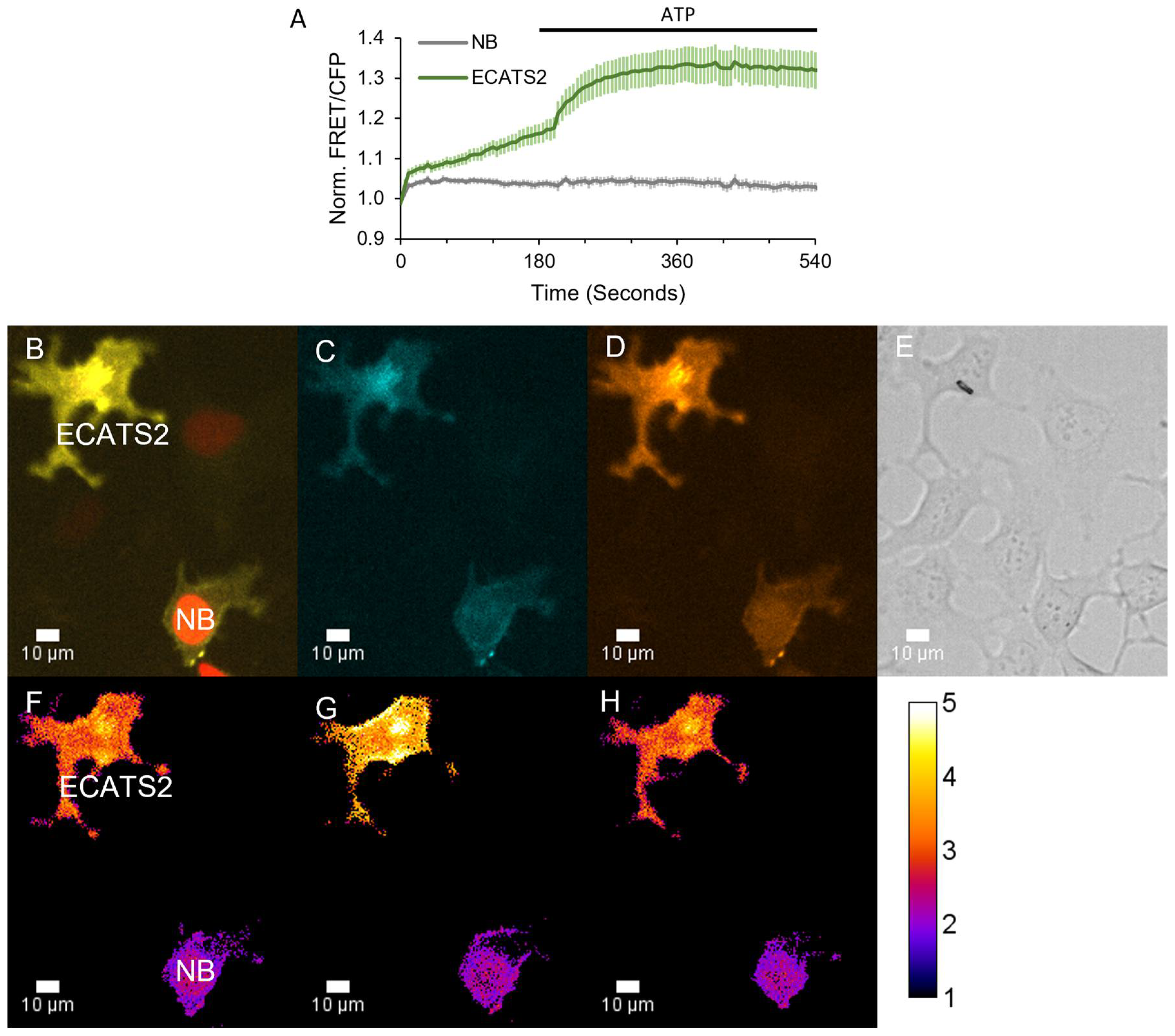
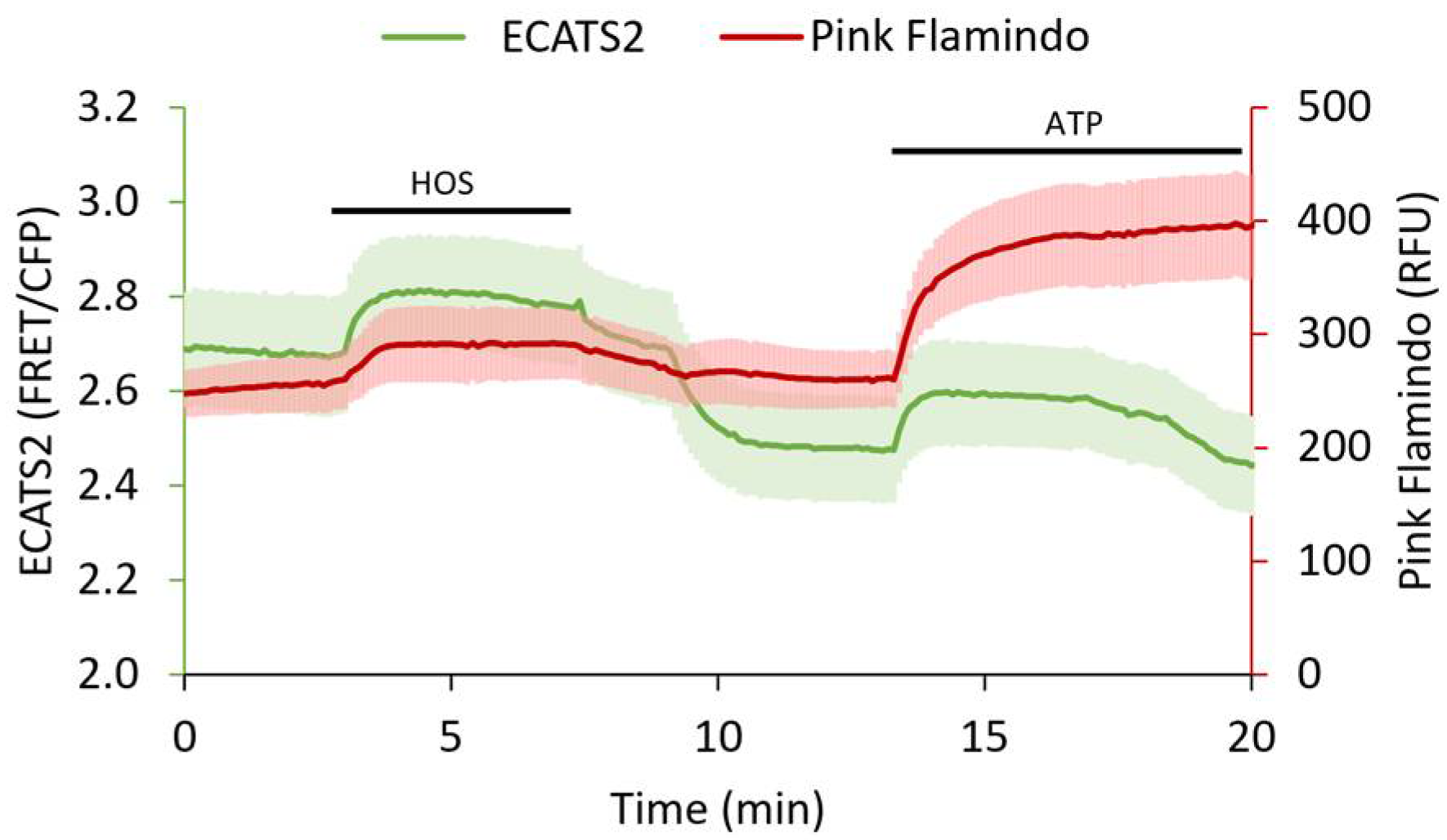
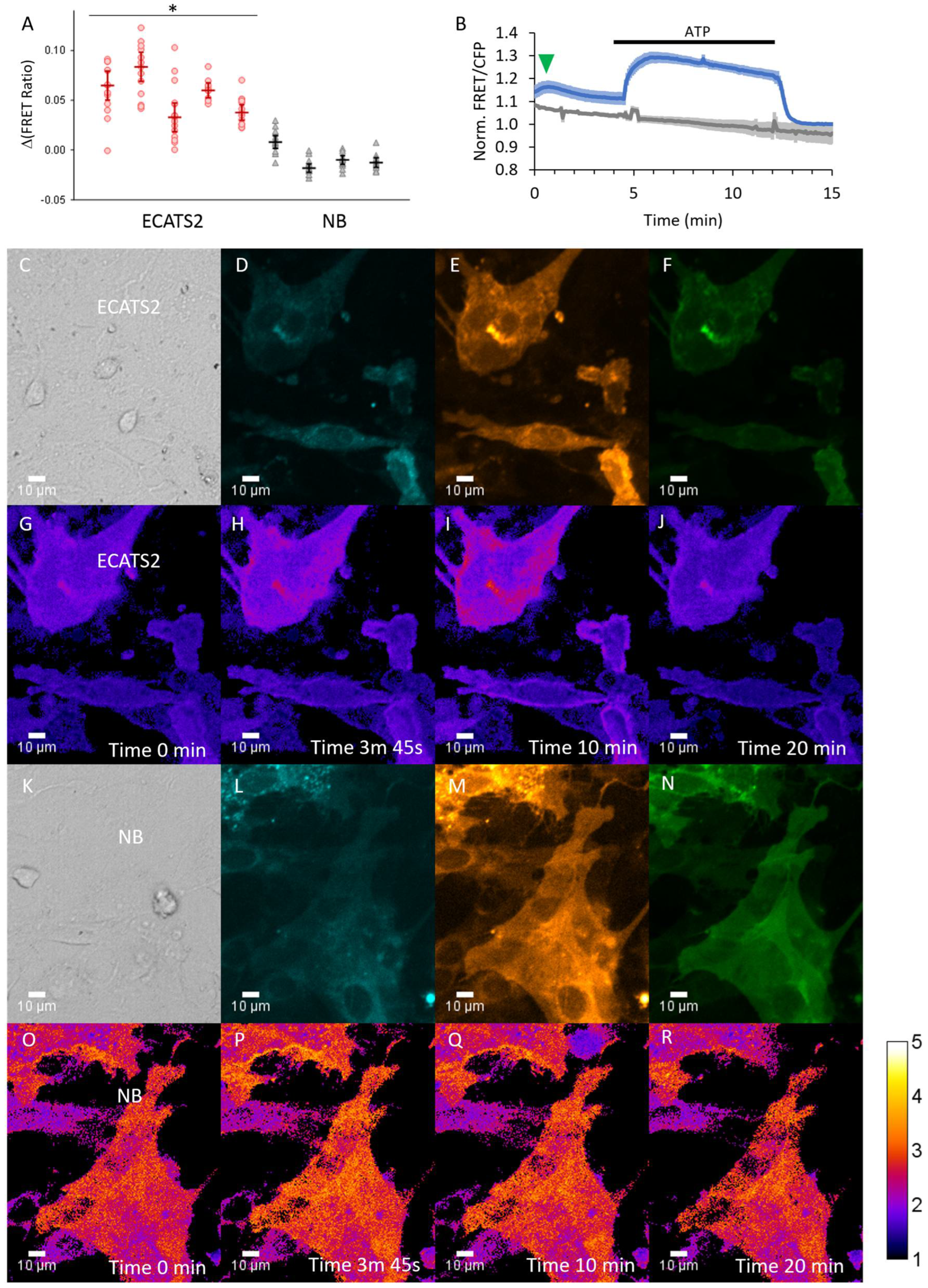
Disclaimer/Publisher’s Note: The statements, opinions and data contained in all publications are solely those of the individual author(s) and contributor(s) and not of MDPI and/or the editor(s). MDPI and/or the editor(s) disclaim responsibility for any injury to people or property resulting from any ideas, methods, instructions or products referred to in the content. |
© 2025 by the authors. Licensee MDPI, Basel, Switzerland. This article is an open access article distributed under the terms and conditions of the Creative Commons Attribution (CC BY) license (https://creativecommons.org/licenses/by/4.0/).
Share and Cite
Cholger, A.; Conley, J.M.; Colomb, E.; de Cuba, O.; Kress, J.; Tantama, M. An Improved Ratiometric FRET Biosensor with Higher Affinity for Extracellular ATP. Sensors 2025, 25, 5903. https://doi.org/10.3390/s25185903
Cholger A, Conley JM, Colomb E, de Cuba O, Kress J, Tantama M. An Improved Ratiometric FRET Biosensor with Higher Affinity for Extracellular ATP. Sensors. 2025; 25(18):5903. https://doi.org/10.3390/s25185903
Chicago/Turabian StyleCholger, Autumn, Jason M. Conley, Elaine Colomb, Olivia de Cuba, Jacob Kress, and Mathew Tantama. 2025. "An Improved Ratiometric FRET Biosensor with Higher Affinity for Extracellular ATP" Sensors 25, no. 18: 5903. https://doi.org/10.3390/s25185903
APA StyleCholger, A., Conley, J. M., Colomb, E., de Cuba, O., Kress, J., & Tantama, M. (2025). An Improved Ratiometric FRET Biosensor with Higher Affinity for Extracellular ATP. Sensors, 25(18), 5903. https://doi.org/10.3390/s25185903





